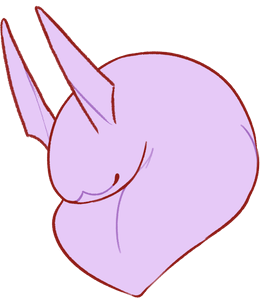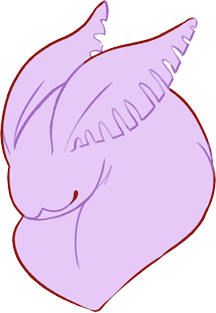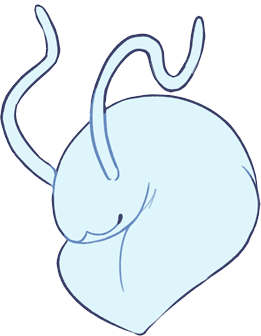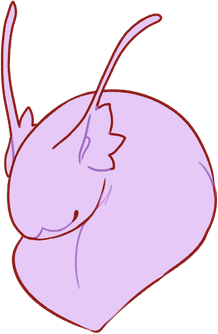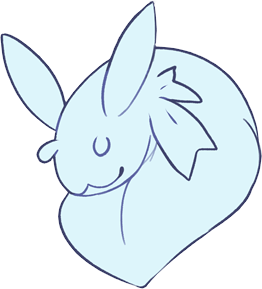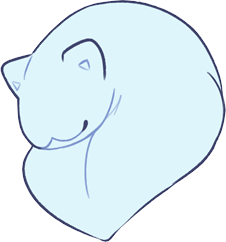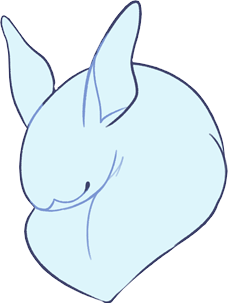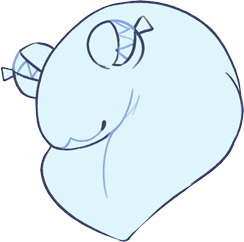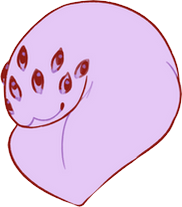Traits
Rhino horn (Normal)
A single thick horn originating from the leech's snout. It's mostly used for mimicry but can carry a powerful punch.
Rhino horned leeches usually have a lazy temperament; they dislike hunting.
Arc horn (Normal)
Two horns that combine as arch in the middle.
It’s considered a regal trait to have, but leeches with this trait are prone to getting objects lodged between their horns.
There's a tale of a hunter following helpless animal cries in the forest, only to find a leech suspended midair with its arc horns stuck on a tree branch.
Anubis ears (Common Myth)
Straight, tall ears which poke rigidly upward. They are notably thinner at the base, flaring out at one side.
This trait is valued by leech breeders for its elegant look. It came into existence thanks to domestication and selective breeding, so it's typically sported by expensive domesticated leeches. Anubis-eared leeches are proud and like to be pampered.
Bat Ears (Cave)
Huge triangular ears with a prominent central spike.
These ears are the second discovered type with the ability to actually hear. The middle spike (also known as the tragus) detects vibrations in the air, notably used for echolocation. Cave leeches with these ears tend to stay in more open spaces, reluctant to slither through tiny gaps and risk damaging the membranes.
Hand ears (Common Myth)
Less of an ear trait, and more of an extra limb trait that sprouted from the head.
They can have any degree of digits, from chunky paws to actual humanlike hands.
A leech's control of these hands varies, but it gets weaker the longer the 'arms' are. Its hypothesized some creatures and monsters in folklore are based off sightings of leeches with this trait.
Many ears (Common Myth)
More than three (3) pairs of ears.
Leeches with this odd mutation are often prone to sensory overload and prefer calm, quiet places. In the wild, these leeches are often hyperaggressive and stressed.
Note: They have to be separate sets of identifiable ears, and listed accordingly. These ears can all be the same type, or different.
Moth ears (Common Myth)
Wide notched ears with a middle vein similar to axolotl, but they're often much broader and softer to the touch.
Their extreme sensitivity is actually because of a coating of very fine hairs. This trait is considered highly luxurious because of its rarity.
Brush ears (Normal)
Extremely delicate wide ears that drape down a leech's face.
A companion trait to brush tail, these ears are so thin-skinned that they tear easily, giving them a ragged appearance.
False wing ears (Normal)
Wide, thin feelers with notches.
They may look stylized and featherlike, but they are made of skin, and built to imitate birds while the leech hides in wait.
Antenna ears (Normal)
Long thin tendrils.
These feelers are incredibly dexterous and are most commonly found on wild class and saltwaters. They enhance the signals feelers already normally pick up, which makes these leeches very potent trackers.
Lynx ears (Common Myth)
Feeler ears (Normal)
Any feeler traits that are in the place of ears, and adhere to their trait rules.
Due to their proximity to the leech's nervous system and brain, these feelers are far more sensitive than body-placed ones, and are used for both mimicry camouflage and for detecting environmental changes such as vibrations, spatial awareness, weather, and body heat signatures.
Note: Feeler type must be included as its own trait; Feeler Ears merely indicates the placement of them. Clustered feelers will need the corresponding upgrade tadpole.
Triangle ears (Normal)
Soft and pointed ears.
Argued to be a variant of cub ears, it’s most often bred on pet class leeches and mimics other animals. The little shaped cavity in each ear attunes the leech more to vibrations of sound, giving the illusion that these ears can hear.
Axolotl ears (Normal)
A combined triple set of feelers, each with a sensitive fan of skin.
These ears are incredible at picking up sound and vibrations in water, but they are just as incredibly fragile. Thankfully, they can be regrown within two weeks if damaged.
Note: There can be more or less than three, but a single pair of the feelers would be classed as the Myth trait moth ears.
Dobby ears (Normal)
Thin-skinned ears that fold in at the base around an ear canal.
Notably, the only ear type that functions properly as ears. They pick up sound, therefore leeches that have this trait rely on hearing more than they do on sound vibration.
Popular on pets for their aesthetic and for allowing the leech to actually hear verbal commands.
Zipper ears (Normal)
Cartilage in a jagged-tooth shape, set into a hollow set of ears that can open to reveal another set of ears underneath.
A companion trait to the tailmouth hoodie. The zipper ears can be any shape, but are generally rounder and smaller than the inside ear set.
Note: The zipper must go the length of the leech's ears from the tip, and cannot cut across them horizontally.
Star tip ears (Normal)
Ears that end in short stylized points.
Most commonly seen in a similar shape to bun ears, they can actually vary from just showing the pointed tips on the head, to hanging down at any length. These ears cannot be moved by the leech.
Note: The tips must remain short. Longer moveable points should instead be classed as the Myth trait, hand ears!
Bun ears (Normal)
Round, long feelers that hang down a leech's face.
They occur most commonly in pets and wild class. Occasionally these ears develop with a slight amount of fat or cartilage, allowing them to stand on end, but the leech cannot otherwise move them.
They have less sensory input than most feelers and ears, and as a result a leech can sometimes be seen chewing on them as some sort of comfort or stress relief.
Over 5 eyes (Common Myth)
In rare cases a leech may develop a surplus of eyes, exceeding the standard maximum of five.
These eyes can be any eye trait, color, shape and size, and can appear clustered or spread across the body. It is considered a genetic mutation more than anything else and often creates some interesting results.
Note: They have to be separate sets of identifiable eyes, and listed accordingly. These eyes can all be the same type, or different.


